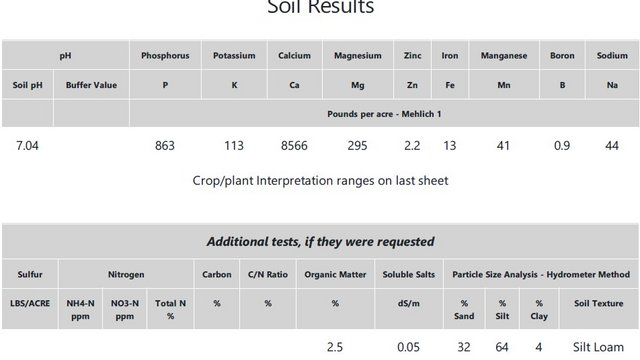Logan Labs Report (samples taken at 4" depth)

UT Report (6" depth combining front/back lawns)

Front Lawn

Back Lawn

LOCATION: Brentwood, TN
AGE OF LAWN: 16 years old, established in 2004
SOIL COMPOSITION: 32% Sand/64% Silt/4% Clay with silt loam texture
GRASS: roughly 16,000 sq.ft. of mostly Turf Type Tall Fescue with 20-30% Bermudagrass. Mowed every 7 days at 4 inch height. The back and front lawns receive full sun most of the day. Minimal thatch (you can see the soil when parting the grass). Aerated yearly.
IRRIGATION: now 0.5" water, 2x/week via automated irrigation system. Previously under watered for years but roots are 4-6 inches deep.
ISSUES: Minimal weeds but invasive Bermudagrass from my neighbor's lawn. The color is lacking that deeper green but I suspect that is from low Fe.
HISTORY: For the previous 3 years I have had a lawncare company fertilize and weed control the lawn. The lawn looked ok but was lacking something and they would not treat for the invasive Bermudagrass. I decided this year to take that over so I could treat the lawn to suppress the Bermudagrass using the treatment regimen recommended by the University of Tennessee for controlling Bermudagrass in TTTF. The thought is to stress the Bermudagrass in late Spring as just comes out of dormancy, don't stress the TTTF in the heat of summer and stress the Bermudagrass as it goes into winter (herbicides are Fusilade II or Pylex in combination with triclopyr). I have 2 dogs.
TREATMENTS THIS YEAR:
March - Lesco 19-0-7 with Dimension (0.5 lb. N/1000 sqft)
April - Lesco 19-0-7 with Dimension (0.5 lb. N/1000 sqft, BioAdvanced Complete Insect Killer for grub control
May 5 - Fusilade II + triclopyr
May 23 - BLKH+3% fulvic acid and BLSC
May 29 - Fusilade II + triclopyr
June 12 - BLKH+3% fulvic and BLSC
EQUIPMENT: Echo RB60 spreader, FlowZone 4 gallon Tornado backpack sprayer with Teejet tips for foliar and soil application, soil probe
FUTURE TREATMENT PLAN:
July-November - app each month of BLKH+3% fulvic and BLSC
July - BioAdvanced Complete Insect Control
August - Pylex + triclopyr
Sept - Pylex + triclopyr and 1 lb. N/1000 sqft (product yet to be determined)
Oct - Pylex only and TTTF overseed (possibly try rhizomatous TTTF), fertilize with 1 lb. N/1000 sqft
Nov - 1 lb. N/1000 sqft (product yet to be determined)
GOALS: I would like a healthy green lawn. I am looking for the best approaches for optimizing the soil and the lawn because I believe good soil makes great grass. I have moderate experience applying fertilizers and herbicides. Thanks for all your help.